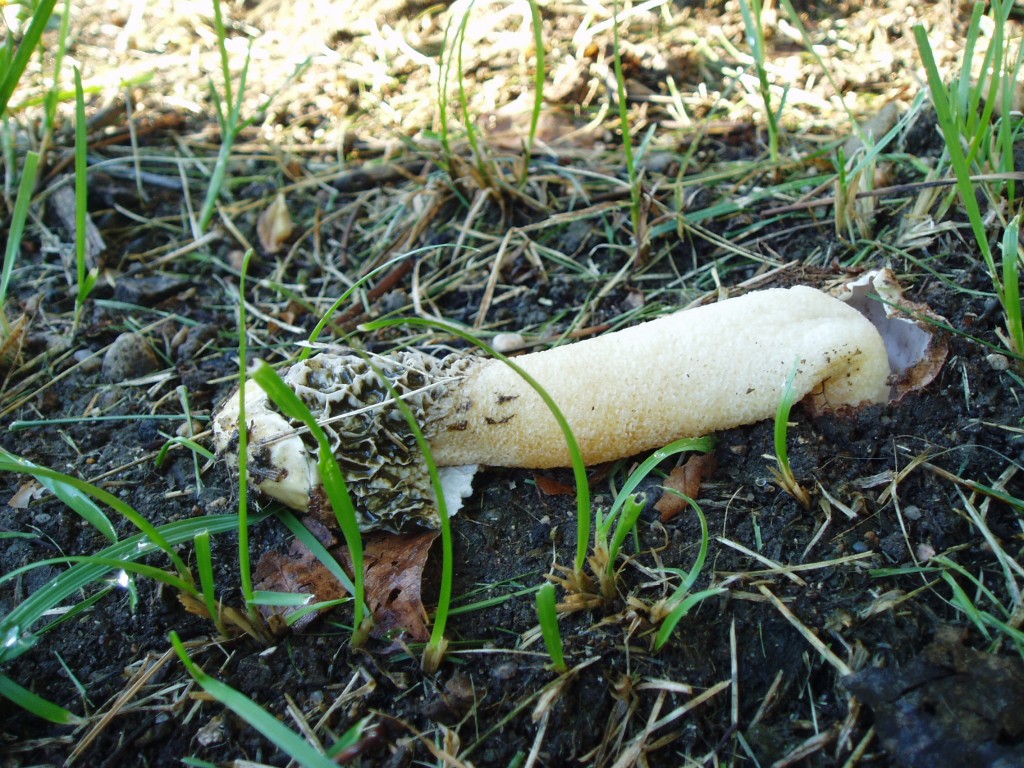You may have noticed I’ve been a bit more . . . MIA than usual. That’s because it’s summer and I’ve been out in the field! One of my latest finds, er . . . popped up this week in very nearly my own back yard: my first-ever stinkhorn. Yes, it took me 32 long years to finally catch one in flagrante delicto.
I covered a new species of African Lacy Stinkhorn in a post here before, but let’s face it: there’s no such thing as too many stinkhorn posts. For those of you who need a refresher, stinkhorns are fungi that hatch from “eggs” enveloped by a peridium (you can see the remains of the peridium at the tip of the head, or receptacle, and at the base of the stalk, above). Some brave souls profess to enjoy eating the eggs. Once the mushrooms hatch and reveal that they are, in fact, quite happy to see the world, they spread their spores by giving them that special odeur de corpse, thereby attracting flies who do the two-step in the sticky, slimy mass of spores at the tip. The flies eat some of the mess; some of the rest clings to their feet. When the flies land elsewhere (i.e. nearby soil, a garbage can, or your sleeping forehead) the spores are deposited in a new, hopefully stinkhorn-friendly place. Then the spore germinates, and microscopic filaments called hyphae spread out through the soil to . . . I’m not exactly sure what. The one thing I cannot discover is whether stinkhorn fungi are wood rotters or symbionts (partners) with the roots of trees or other plants, the two chief fungal m.o.s.
They’re in the same general group as the gilled mushrooms, but in a special family all their own called the Phallaceae. (Fal-ace’-ee-ay) Some of their brethren are among the most striking fungi on the planet: the earth stars, earth cages, and the lacy stinkhorns, which have a demure, delicate skirt jarringly draped around the obscene fungus. This group, in turn, is in the Agaricomycetes (the mushrooms and friends) which is in turn in the Basidiomycota, which those of you who are *really* good will remember are the fungi that make their spores on club-shaped cells called basidia. Basidiomycota are one of the basic, top-level groups of fungi.
When I first spotted this particular specimen on Wednesday, it was standing tall and proud. But alas, by yesterday, it had toppled over into this sorry state. That wasn’t discouraging to a nearby retinue of flies, so perhaps the stinkhorn wasn’t so sad as I’m making out . . .
To see how the stinkhorns, et al, fit into to the life family tree, look for Phallomycetidae here. Click the arrow at left to back out, or follow the link of the group’s name to see a bit more about who they’re related to.



{ 2 comments… read them below or add one }
those other striking fungi are amazing! this guy, not so much :p
I know. You almost want to say, “Don’t worry, little buddy, it happens to every stinkhorn. . . . “